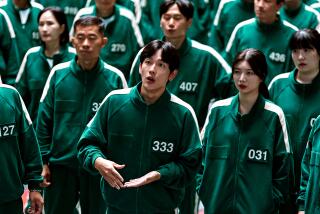Commentary: ‘Stranger Things 3’ is an anxious ode to ’80s consumerism
- Share via
The American mall may be dying, but in “Stranger Things 3,” it’s alive and well.
When it debuted in 2016, “Stranger Things” became a surprise hit for Netflix by tapping into nostalgia for the pop culture of the 1980s. Following mysterious events in the small town of Hawkins, Ind., in fall 1983, the series — created by the Duffer brothers — enticed viewers with an irresistible mash-up of references to “E.T. the Extra-Terrestrial,” “Ghostbusters,” “Poltergeist,” “Firestarter,” “Stand By Me” and more.
Set in summer 1985 — as “Back to the Future” rides high at the box office and syrupy-sweet New Coke faces a backlash — the latest installment takes its obsession with Reagan-era consumer culture to a new level. Premiering July Fourth like the blockbuster franchise “Stranger Things” has become, the new season revives two of the decade’s defining features: the Cold War and the shopping mall.
Brands have always been central to “Stranger Things” (See: Eleven’s fondness for Eggos), but the third installment and its accompanying 75 promotional agreements focus the attention on materialism more than ever before. Now, the series is literally set at the mall: After two seasons at the modest Byers household, the center of action has shifted to the dazzling, new Starcourt Mall. It boasts now-defunct franchises (Sam Goody, Waldenbooks), stalwart chains (the Gap, Burger King) and businesses redolent of the 1980s but technically still in operation (Orange Julius, Jazzercise, Claire’s).
One of the few fictional embellishments at Starcourt — actually the Gwinnett Place Mall in Duluth, Ga., — is an ice cream parlor named Scoops Ahoy, where reformed bad boy Steve (Joe Keery) works alongside acerbic newcomer Robin (Maya Hawke, daughter of people-who-became-famous-in-the-’80s Ethan Hawke and Uma Thurman).
The shopping center has became a favorite hangout for the increasingly hormonal adolescents at the center of “Stranger Things.” Not even Eleven (Millie Bobby Brown), with her supernatural powers, can resist its consumer delights: In a makeover montage set to — what else? — Madonna’s 1985 hit, “Material Girl,” she shops for a brightly colored new wardrobe to replace her grungy hand-me-downs.
More than just a pastiche of beloved ’80s movies, “Stranger Things 3” is a celebration of consumerism itself, of a go-go era when shopping malls were important not just as hubs of commerce but also as shared spaces where teenagers folded T-shirts for minimum wage or hung out aimlessly the way they now do on social media.
But while we have an ’80s real-estate developer as president, our consumer habits have changed dramatically since the days when we had to schlep to the mall to buy a record or drive to the video store to browse the newest releases. Once a fixture of American suburbia, the shopping mall is increasingly endangered, thanks not to a Soviet-style workers’ revolution but to online retailers like Amazon. Malls once valued for hundreds of millions are now almost worthless or have been repurposed into churches and medical centers.
REVIEW: ‘Stranger Things 3’ finds new horrors...at the mall. Aiee! »
We no longer drink as much soda as we used to, either. DVRs and streaming networks like Netflix have made us less tolerant of commercials than we were in the era when “Where’s the Beef?,” the California Raisins and Spuds MacKenzie were cultural touchstones. Video stores have gone the way of the dodo bird and even the multiplex — another recurring location in “Stranger Things 3” — is in jeopardy.
Still, we continue to have warm and fuzzy feelings for the mall, even if it’s an artifact as outdated as the perm. A few years ago, pictures taken by photographer Michael Galinsky at malls across the country in the late ’80s were published in stories by Buzzfeed and Mashable that quickly went viral. (Copies of his coffee table book go for hundreds of dollars on Amazon.) Interest in “dead malls” has spurred blogs, Facebook groups, a popular genre of YouTube videos and haunting photojournalism.
Brands have enthusiastically latched onto “Stranger Things” and its sentimental portrayal of a bygone era in consumerism. Not only is the release of New Coke a significant subplot in “Stranger Things 3” but Coca-Cola has also reintroduced the ill-fated beverage in a limited-edition collector’s pack (cost: $19.85). Retailers including H&M, Nike and Levi’s have introduced lines of faux-vintage clothing inspired by “Stranger Things.” And Burger King, which happens to have a prominent fictional location at the Starcourt Mall, is introducing an Upside Down Whopper.
Television is awash in depictions of the 1980s, from the gently feminist kitsch of “GLOW” to the horrors of “Chernobyl” to the heartfelt exuberance of “Pose.” Hideous, flesh-dissolving monsters notwithstanding, “Stranger Things” takes a sunnier, more optimistic view of the era as a kinder and gentler period of capitalism, before the rise of the gig economy and talk of a “rigged system” became part of the mainstream political discourse. (Whether this is an accurate view is another matter: The Center on Budget and Policy Priorities traces the income inequality of the present to the 1980s.)
Certainly, it’s striking that Americans once trusted in corporations enough that the release of New Coke felt like a profound betrayal, and earnestly picking a side in the Cola Wars was as normal as rooting for a football team. Belief in capitalism was reflected in the serial drama of the Cold War, in the triumph that came when the American team beat the Soviet Union’s at the Olympics or when a prominent athlete, artist or intellectual defected from the Eastern Bloc.
“Stranger Things 3” enthusiastically feeds this simplistic narrative. Starcourt has also attracted an unwelcome element: the Soviet military, which has secretly opened a portal to the Upside Down beneath the mall’s foundations. The series portrays the Russians as interchangeable, one-dimensional villains who are even less developed than the shape-shifting Mind Flayer monster. (Many of the films this season draws from — “Back to the Future,” “War Games,” “Rocky IV,” “Red Dawn” — had a similarly cartoonish view of geopolitics.) The only sympathetic or even somewhat developed Russian character is Dr. Alexei (Alec Utgoff), a scientist quickly seduced by American culture.
Most of their young American counterparts are enthusiastic boosters of Western decadence, though. In one of the season’s many comedic moments — the tone of “Stranger Things 3” is noticeably lighter, reflecting its summertime setting — precocious tween Erica Sinclair (Priah Ferguson) delivers an economics lecture that sounds like something Milton Friedman — or better yet, Alex P. Keaton — would say.
“You know what I love the most about this country? Capitalism,” she says in a bid to convince Robin and Dustin (Gaten Matarazzo) that she deserves free ice cream for life. “Do you know what capitalism is? It means this is a free-market system, which means people get paid for their services depending on how valuable their contributions are.”
But like Soviets underneath the Starcourt Mall, there is anxiety below the surface of “Stranger Things 3.” At a carnival, Murray Bauman (Brett Gelman) warns Alexei not to play any of the “rigged games.” “They have been designed to present the illusion of fairness,” he says. “But it’s all a scam, a trick, to put money in the rich man’s pocket. That, my dear friend, is America.”
Elsewhere, Nancy (Natalia Dyer), an aspiring cub reporter at the local paper — remember those? — pitches a story about Starcourt’s effect on Hawkins’ economy.
“I know everyone loves the mall, but how many small businesses have closed since it opened? Five on Main at least,” she says. “It’s changing the fabric of our town.” Replace “mall” with “Amazon Prime” — or, for that matter, “Netflix” — and it’s a conversation straight out of 2019.
There’s a pointed irony to the series’ affection for the days of brick-and-mortar retail. This season includes scenes not only at the Starcourt shops but also at the multiplex and the video store, moments designed to conjure wistful “remember when” feelings from those of us old enough to have possessed a Blockbuster card. “Stranger Things” is a phenomenon that has played a major role in turning Netflix into a programming giant. But this season, it’s also a paean to shared cultural experiences that the service has helped make obsolete.
====
‘Stranger Things 3’
Where: Netflix
When: Any time
Rating: TV-14 (may be unsuitable for children younger than 14)
====
Follow me @MeredithBlake
More to Read
The complete guide to home viewing
Get Screen Gab for everything about the TV shows and streaming movies everyone’s talking about.
You may occasionally receive promotional content from the Los Angeles Times.






